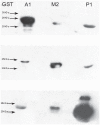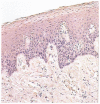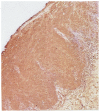Functional activities and immunohistochemical cellular distribution of glutathione s-transferases in normal, dysplastic, and squamous cell carcinoma human oral tissues
- PMID: 20305732
- PMCID: PMC2841403
- DOI: 10.4137/cmo.s491
Functional activities and immunohistochemical cellular distribution of glutathione s-transferases in normal, dysplastic, and squamous cell carcinoma human oral tissues
Abstract
Clinical data show a strong correlation between tobacco and alcohol use and the development of oral squamous cell carcinoma (SCC). While this association implies that the oral mucosa actively metabolizes carcinogens, there is little information which depicts the carcinogen metabolizing enzymes within the oral cavity. Glutathione S-transferases (GSTs) primary function is to detoxify carcinogens by increasing their water solubility, GSTs represent key carcinogen metabolizing enzymes. Notably, individuals with a null phenotype for certain GST isoforms are at an increased risk to develop cancer. This study investigated the function and distribution of GSTs in human oral tissues. Our results from this pilot study showed a trend towards higher GST activities in SCC tissues relative to normal mucosa. Also, relative to normal tissues, the SCC and epithelial dysplasia samples showed a more intense and uniform GST intracellular distribution. GST activities are increased in many high grade cancers. Similarly, our data suggest that GST upregulation occurs in at least a subset of precancerous and malignant oral lesions.
Keywords: carcinogen metabolism; dysplasia; glutathione transferases; oral squamous cell carcinoma.
Figures




Similar articles
-
Increase in placental glutathione S-transferase in human oral epithelial dysplastic lesions and squamous cell carcinomas.J Oral Pathol Med. 1994 Feb;23(2):75-9. doi: 10.1111/j.1600-0714.1994.tb00260.x. J Oral Pathol Med. 1994. PMID: 8164157
-
Curcumin activates the aryl hydrocarbon receptor yet significantly inhibits (-)-benzo(a)pyrene-7R-trans-7,8-dihydrodiol bioactivation in oral squamous cell carcinoma cells and oral mucosa.Cancer Res. 2002 Oct 1;62(19):5451-6. Cancer Res. 2002. PMID: 12359752
-
Immunohistochemical demonstration of epithelial glutathione S-transferase isoenzymes in normal, benign, premalignant and malignant human oral mucosa.J Oral Pathol Med. 1995 Aug;24(7):316-21. doi: 10.1111/j.1600-0714.1995.tb01192.x. J Oral Pathol Med. 1995. PMID: 7473269
-
Glutathione S-Transferase Enzymes in Plant-Pathogen Interactions.Front Plant Sci. 2018 Dec 21;9:1836. doi: 10.3389/fpls.2018.01836. eCollection 2018. Front Plant Sci. 2018. PMID: 30622544 Free PMC article. Review.
-
The role of glutathione S-transferases in human disease pathogenesis and their current inhibitors.Genes Dis. 2024 Dec 5;12(4):101482. doi: 10.1016/j.gendis.2024.101482. eCollection 2025 Jul. Genes Dis. 2024. PMID: 40290119 Free PMC article. Review.
Cited by
-
Considering SOD and miRNA analysis as potential prognostic markers in white lesion malignant transformation: A report of two cases.Medicine (Baltimore). 2024 Dec 13;103(50):e40928. doi: 10.1097/MD.0000000000040928. Medicine (Baltimore). 2024. PMID: 39686488 Free PMC article.
References
-
- Alin P, Danielson UH, Mannervik B. 4-Hydroxyalk-2-enals are substrates for glutathione transferase. FEBS Lett. 1985;179(2):267–70. - PubMed
-
- Bongers V, Snow GB, Braakhuis BJM. The role of glutathione S- transferases in head and neck squamous cell carcinogenesis. Eur. J. Cancer B. Oral Oncol. 1995;31B(6):349–54. - PubMed
-
- Chasseaud LF. The role of glutathione and glutathione S-transferases in the metabolism of chemical carcinogens and the other electrophilic agents. Adv Cancer Res. 1979;29:175–274. - PubMed
-
- Di Ilio C, Del Boccio G, Aceto A, et al. Elevation of glutathione transferase activity in human lung tumor. Carcinogenesis. 1988;9:335–40. - PubMed
-
- Di Ilio C, Del Boccio G, Aceto A, et al. Alteration of glutathione transferase isoenzyme concentrations in human renal carcinoma. Carcinogenesis. 1987;8:861–4. - PubMed
Grants and funding
LinkOut - more resources
Full Text Sources
Research Materials

